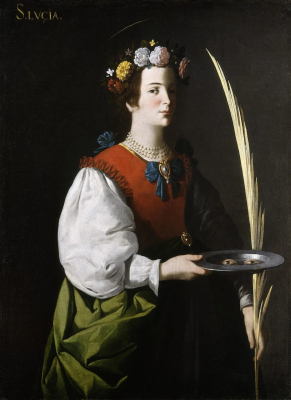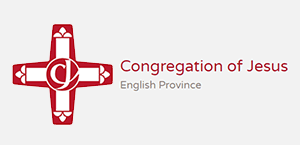Gospel in Art: Feast of Saint Lucy, Virgin and Martyr

Saint Lucy, by Francisco de Zurbarán, 1625/1630 © National Gallery of Art, Washington
Source: Christian Art
Gospel of 13 December 2023
Matthew 11:28-30
Jesus said, 'Come to me, all you who labour and are overburdened, and I will give you rest. Shoulder my yoke and learn from me, for I am gentle and humble in heart, and you will find rest for your souls. Yes, my yoke is easy and my burden light.'
Reflection on the painting
Today we celebrate Saint Lucy. She was martyred in Syracuse, probably during the Diocletian persecutions, which started in 303 AD. Our painting is an unusual portrait of the saint by Francisco de Zurbarán, depicting Lucy from about the hips up. She is shown as a young woman with smooth, light skin, rosy cheeks, dark brown hair and with a crown of flowers on her head. Zubaran portrays the young martyr as a contemporary woman of 17th-century Seville. In one hand she holds the palm of martyrdom and in the other, a pewter plate with two human eyes on it.
Legend has it that Lucy, determined to dedicate her life to Christ, plucked out her own eyes and sent them to a tenacious suitor after he insisted that the beauty of Lucy's eyes allowed him no peace. Astounded by her devotion to her faith, the admirer converted to Christianity, and Lucy, the legend continues, later found her eyesight miraculously restored one day during prayer. It is possible that the young saint's connection with eyes originated in the Latin source for her name, Lux or "light," which is inextricably linked with vision.
And we are now less than two weeks away from the true light coming into our world at Christmas…
Lucy died a martyr. The Roman persecutors prepared a large fire to burn Lucy at the stake. However, when they lit the fire, the flames moved away from her body, refusing to touch her, physically avoiding contact with her flesh, as if the flames recognised that she was a saintly person. She emerged from the fire unscathed and then spoke eloquently about her faith, giving it as the reason why she wasn't consumed by the flames. In the same speech she also predicted that persecution of the Christians would soon be over. How right she was. Less than ten years later the Edict of Milan was passed by Emperor Constantine, giving Christians the ability to worship freely throughout the Roman Empire. The Romans felt angered and humiliated by Lucy's words and a young soldier was ordered to kill her, which he did by cutting her throat. She died on 13th December 304 AD.
LINKS
Gospel in Art: https://christian.art/
Today's Reflection: https://christian.art/daily-gospel-reading/matthew-11-28-30-2023-2/


















